Journalists are eligible for free email subscriptions to SEJournal, including TipSheet, WatchDog (on access issues) and more.

The Society of Environmental Journalists is proud to present the winners of the 2013-2014 Awards for Reporting on the Environment. SEJ’s journalism contest is the world’s largest and most comprehensive awards for journalism on environmental topics.
Twenty-one entries in seven categories have been selected. Reporters, editors and journalism educators who served as contest judges pored over 313 entries to choose the finalists representing the best environmental reporting in print and on television, radio and the Internet.
SEJ honors this year’s winners Wed., Sept. 3, at a gala ceremony at the Hilton New Orleans Riverside hotel, New Orleans, Louisiana, in conjunction with SEJ's 24th Annual Conference.
SEJ's 2014 Awards for Reporting on the Environment are...
Kevin Carmody Award for Outstanding In-depth Reporting, Large Market
Kevin Carmody Award for Outstanding In-depth Reporting, Small Market
Outstanding Beat Reporting, Large Market
Outstanding Beat Reporting, Small Market
Outstanding Feature Story
Outstanding Environmental Photojournalism
Rachel Carson Environment Book Award,
SEJ’s 2014 Distinguished Judges
Kevin Carmody Award for Outstanding In-depth Reporting, Large Market
First Place
"Sea Change | The Pacific’s Perilous Turn" by Craig Allen Welch and Steve Ringman, for the Seattle Times
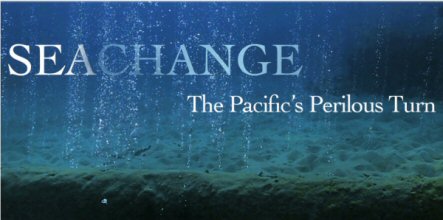 Judges' comments: The bigger the disaster, the greater the hubris that preceded it. We often rationalize that the skies, land and water are too enormous, and we are too puny, to change them. "Sea Change" is a brilliant, comprehensive and utterly terrifying series from Seattle Times reporter Craig Welch and photographer Steve Ringman in which they make the case that we’re changing even the basic chemistry of our oceans.
Judges' comments: The bigger the disaster, the greater the hubris that preceded it. We often rationalize that the skies, land and water are too enormous, and we are too puny, to change them. "Sea Change" is a brilliant, comprehensive and utterly terrifying series from Seattle Times reporter Craig Welch and photographer Steve Ringman in which they make the case that we’re changing even the basic chemistry of our oceans.
Welch’s writing combines strong storytelling with clear, accessible science reporting to describe the scope of ocean acidification from remote islands to the local fish market. Ringman’s images, and the graphics and videos accompanying the pieces, fill in the blanks and drive home the global peril in “global warming’s evil twin.”
The fate of dinner-table megafauna like pollock and king crab lay in the balance. So does the fate of less glamorous ocean residents like pteropods and sea urchins. Add it all up and acidification looms as potentially the biggest insult humanity could deliver to its home planet.
Welch relies on scientists, both commercial and subsistence fishers, and even a climate-denying politician who needs no convincing on acidification’s dire threat. "Sea Change" is a model of well-done big project journalism — the type that only happens when talented journalists enjoy support from their editorial bosses. It is a worthy recipient of the Carmody Award.
Second Place
"The Facts About GMO’s" by Amy Harmon, for The New York Times
Judges' comments: Genetically modified organisms have the potential to combat plant diseases and help feed a warming, overpopulated planet. Yet the public is not convinced, in part because of opposition that’s based on fear not facts. Amy Harmon’s detailed and compelling series for The New York Times challenges the conventional story line about GMOs.
She builds her pieces around characters whose experiences illustrate the larger narrative. A Florida orange grower whose crop is threatened by a devastating bacterium knows that genetic engineering could offer a cure, but wonders if consumer hostility to all things GMO will doom his orange juice in the court of public opinion.
A Hawaiian county council member who did his own research to understand the issue comes to realize — as does the reader — that emotion, not science, has driven the debate.
In the developing world, a strain of rice modified to provide a key vitamin has not yet reached the hungry because of protests. In this story, Harmon focuses on misplaced fears. There were many worthy submissions for this year’s Carmody prize. Harmon’s project rose to near the top for her meticulous, dispassionate reporting that illuminates both the false arguments and the solid science.
Third Place
"Crude Solution: BP Oil Spill Health Concerns Investigation" by Jo Townsend and Michael Usher, for Nine Network Australia
Judges' Comments: Four years since the 2010 Deepwater Horizon Spill captured the attention of so many reporters and produced so many fine pieces of journalism, it's a pleasure to watch such a brilliantly-reported and produced follow-up that resulted in measurable impacts. Jo Townsend and Michael Usher’s poignant examination of the devastating health effects not of the oil itself, but of the dispersants used to supposedly clean it up — an issue that was much less in the news in the aftermath of the spill — is gripping to watch. Not only does this "60 Minutes" program deeply affect viewers by taking them into the destroyed or forever altered lives of residents whose health was impacted by CoRexit, but it also convinces us using clear, succinct explanations of the sound science behind those health claims. If that's not enough, the piece has a measurable impact on policy during the actual reporting process, and viewers get a front seat to the show, when reporter Michael Usher puts Australia's chief offshore drilling regulator on the spot over the country's lack of oversight — and soon after, the country makes a decision to stop using CoRexit in its own oil spill operations. Townsend and Usher's work is a fantastic example of investigative journalism that not only delves into a serious problem, but also presents, and achieves, real solutions.
Kevin Carmody Award for Outstanding In-depth Reporting, Small Market
First Place
"Toxic Clout" by David Heath, Ronnie Greene and Jim Morris, for The Center for Public Integrity
 Story Links:
Story Links:
- "High Bladder Cancer Rate Shrouds New York Plant, Exposing Chemical Hazards in the Workplace"
- "Berkley Training Helps Researchers Work Around Potential Conflicts"
- "In New Battleground Over Toxic Reform, American Chemistry Council Targets the States"
- "Lauded Public Health Researcher Also Worked for Industry, Revealing Entanglements of Science"
- "Facing Lawsuits Over Deadly Asbestos, Paper Giant Launched Secretive Research Program"
Judges' comments: This year-long investigation convincingly revealed how chemical industry influence and regulatory malaise create uncertainty and delay, putting public health at risk. One of the most striking stories showed how a University of California public school health dean had worked for decades as an expert for industry, which posed a very real conflict of interest. Another story, revealing an EPA advisory panel’s ties to the chemical industry, prompted the agency to write tighter conflict of interest rules. This is an outstanding example of journalism with an impact on issues that affect us all.
Second Place
"The Tree Coroners" by Cally Carswell, for High Country News
Judges' comments: As we are forced to deal with the many challenges of a warming and changing climate, Cally Carswell’s well-written, educational and entertaining story created a narrative that most certainly heightened public awareness about an important topic that is often overlooked when discussing the planet’s growing carbon footprint: the vital role trees play. By better understanding how and why trees are dying, we can incorporate better forest management and land-use practices. This story highlighted the challenges of this important work.
Third Place
"Exhausted at School" by Olivia Henry and Kate Martin, for InvestigateWest
Story Links:
- "Exhaust, Diesel Fumes Foul Public Schoolyards Across Washington State"
- "Map: Schools and Road Pollution in Washington State"
- "Officials in Olympia, D.C. Ducked Opportunities To Protect Students from Traffic Pollution"
- "More Than 100 Washington Day Cares Dangerously Close to Pollution-Clogged Roadways"
Judges' comments: With good document diving and mapping, InvestigateWest’s Olivia Henry, along with Kate Martin, showed how thousands of Washington state school children are breathing dirty and at times dangerous air because their schools are next to highways where car fumes linger. Henry dug into the details of school siting, public health, politics, federal and state bureaucracies, and even private day cares for a compelling read about a problem that few people knew about or pay attention to. And the students of at least one school have her to thank for a better air filtration system instead of one from the 1950s.
Beat Reporting, Large Market
First Place
South Florida Environmental Coverage by Curtis Morgan, for The Miami Herald
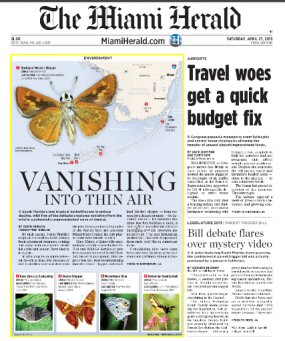 Story Links:
Story Links:
- "Vanishing into Thin Air"
- "Deep Trouble"
- "On the Brink of Disaster"
- "New Oil Rigs May Soon Sprout in S. Fla."
- "Keys Drone To Buzz Skeeters"
Judges' comments: With creative angles, lively writing, and clear explanations of complex topics, Curtis Morgan's stories about South Florida's environment are a pleasure to read. His colorful turns of phrase roam from "ephemeral creatures" — vanishing butterfly species — to the "sobering scenarios" of climate change, the "sluggish bureaucracy" of the Army Corps of Engineers' levee maintenance, the "ripple effects" of a regional oil rush, and a mosquito-control agency's attempt to fly a $65,000 drone for "a high-tech edge" against "the swarms (of) bloodsucking buzzers." Moreover, he's earned the backing of a major daily paper that gives his stories good play (often front page) and elaboration with maps and other graphics, for an unusually engaging presentation of important environmental issues.
Second Place
Environmental Reporting in Asia by Coco Liu, for ClimateWire and Scientific American
Story Links:
- "What Happens When Asia's Water Tower Dries Up?"
- "As China's Demand for Coal Soars, So Does Its Water Scarcity"
- "Electric Rickshaws Give Nepal a Charge"
- "Bhutan Prospers by Exporting 'Sustainable' Energy, But Some Doubt That It Is"
- "Renewable Energy, Once a Dream, Lights up Some of India's Slums"
Judges' comments: Too often, stories on climate and environmental issues make passing mention of the vulnerabilities of those who live in developing nations, often quoting a report or an expert who may (or may not) have visited. Coco (Ying) Liu’s stories do what journalists are supposed to do: go to the place and report on the people who will be affected. She tells the stories of environmental assaults through the eyes of a photographer in remote China who no longer has a shimmering lake to photograph; a coal town in Inner Mongolia hoping to ship seawater 600 kilometers so it can mine more coal; electric rickshaw drivers in Nepal; a villager in Bhutan who is refusing to move for construction of a hydro dam; an Indian slum near Bangalore cobbling solar to huts and cellphones. Woven into these accounts is fulsome context based on solid and critical reporting and good interviews, all the more difficult in the press-wary regions in which she is working. She does this as a reporter largely working on her own, without the support of big newsroom budgets and staff.
Third Place
Beat Reporting in Maryland by Tim Wheeler, for The Baltimore Sun
Story Links:
- "Shad’s Dismal Numbers Put Conowingo in Sharp Focus"
- "O'Malley Lobbies EPA on Fuel Rule"
- "Fish Kills, Toxic Algae Plague Shore Creek"
- "Toxic Metal in Wells and Air"
- "Maryland Eyes Major Expansion of Its Wildlands"
Judges' comments: Tim Wheeler’s long-time focus on the environment beat and his deep knowledge of the issues are evident in the five excellent articles he submitted for consideration. His reporting is intelligent, comprehensive and informative. In the competitive format of a daily urban newspaper, he was successful in writing long stories — all of them printed on Page One — that provided a multi-faceted view of an issue, depicting topics that are not easily resolved. He submitted a wide range of environmental coverage from chromium contamination and environmental decisions tied to politics to wild lands protection, the efficacy of replenishing fish stocks and local communities addressing a toxic natural habitat. His writing is graceful, thoughtful, lively, and infused with the statistical information that is the backbone of excellent reporting.
Outstanding Beat Reporting, Small Market
First Place
“Sayonara, Polystyrene” and Other Stories by Cheryl Hogue, for Chemical & Engineering News
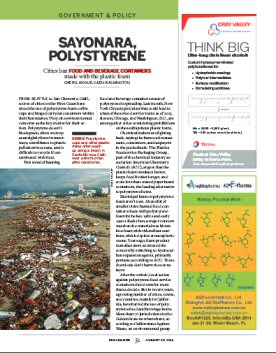 Story Links:
Story Links:
- "Sayonara, Polystyrene"
- "Microplastic Beads Pollute Great Lakes"
- "Chemical Lawsuits"
- "Changing How EPA Gets Science Advice"
- "A Back Channel for Big Companies?"
Judges' comments: Cheryl Hogue's early reporting on how micro-beads from personal care products are contaminating our water bodies — a story later picked up by larger outlets — first caught the judges' eyes. Her clear, direct writing pulls readers through what could otherwise be dense patches of information, and her stories give readers important insight, including on how the Small Business Association has become a mouthpiece for big industry on chemical issues.
Second Place
Stories of the Great Lakes’ People, Places and Creatures by Brian Thomas Bienkowski, for Environmental Health News
Story Links:
- "Sewage Adds to Detroit's Headache"
- "Out of Sight, Out of Mind: Carcinogenic Chemical Spreads Beneath Michigan Town"
- "Contaminated Tribe: Hormone-Blocking Chemicals Found in First Nation Families"
- "Chemicals on Federal Radar Pervasive in Chicago Air"
- "Yellow Pigments in Clothing, Paper Contain Long-Banned PCB"
Judges' comments: Brian Bienkowski's solid storytelling on a range of topics impressed the judges. His story on Detroit's overflowing sewers was alarming, as was a piece about a carcinogenic chemical spreading in the groundwater beneath a Michigan town. His reporting was thorough and his writing keeps readers engaged.
Third Place
Water in the United States by Brett Walton, for Circle of Blue
Story Links:
- "Who Will Pay for Disposal? Drug Companies Lose Against Local Governments in California and Washington"
- "Fortune Telling: Colorado River Teeters Toward First-ever Shortage Declaration"
- "The Price of Water 2013: Up Nearly 7 Percent in Last Year in 30 Major U.S. Cities; 25 Percent Rise Since 2010"
- "Texas High Plains Prepare for Agriculture Without Irrigation"
- "Bad Report Card: Low Marks — Again — For U.S. Water Infrastructure"
Judges' comments: Brett Walton's stories on the timely topic of drought brought out the calculations and competing interests for water in three major western states, and he spun the issue out to the international level. The judges liked his easy, digestible writing style.
Outstanding Feature Story
First Place
"A Tale of Two Forests: Addressing Postnuclear Radiation at Chernobyl and Fukushima" by Winifred Bird and Jane Braxton Little, for Environmental Health Perspectives
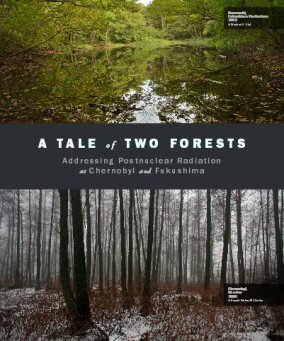 Judges' comments: As the cliché goes, you can't know where you are headed unless you know where you've been, which is what makes "Tale of Two Forests" both an exceedingly vital and original piece of environmental feature writing. The best stories are those that make other journalists wish they had thought of it first, and that's certainly the case with their compelling and meticulously researched examination of how the nuclear disaster at Chernobyl should — but isn't necessarily — guiding the actions of those cleaning up after Japan's Fukushima meltdown.
Judges' comments: As the cliché goes, you can't know where you are headed unless you know where you've been, which is what makes "Tale of Two Forests" both an exceedingly vital and original piece of environmental feature writing. The best stories are those that make other journalists wish they had thought of it first, and that's certainly the case with their compelling and meticulously researched examination of how the nuclear disaster at Chernobyl should — but isn't necessarily — guiding the actions of those cleaning up after Japan's Fukushima meltdown.
Second Place
"The Damage Done" by Kelly B. Conde, for The Missoula Independent
Judges' comments: In "Damage Done," journalist Kelly Conde reports on the devastating effects of unbridled environmental exploitation and makes it personal, by bringing to life the stories of the people who have been profoundly affected. This is a well-told piece about one community's struggle to ensure that their water is safe. It is also a universal story that speaks to the impact that resource extraction has on countless communities around the world.
Third Place
"The New Flight of the Ibis" by Chelsea Wald, for Nautilus
Judges' comments: At a time when so much reporting on the environment is discouraging, if not downright depressing, along comes a feature story that lifts the reader off the ground with hope. Writer Chelsea Wald introduces a determined scientist who teaches himself to fly so that he can train a flock of northern bald ibises, nearly extinct, to migrate again. And while Wald's story covers many years and much frustration, she does it with a light touch. The story of this unusual conservation project is not without tragedy, but the overall takeaway is refreshingly sweet.
Outstanding Environmental Photojournalism
First Place
"The Price of Precious" by Marcus Bleasdale, for National Geographic
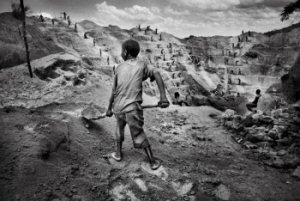 |
| Click to enlarge. © Marcus Bleasdale. |
Photo 1 (right): A child is put to work at a militia-run mine in Watsa. Marcus' body of work of the Congo spans 13 years. This image, made in 2004, represents his earlier black-and-white images of the conflict mineral trade.
Photo 2: Workers rip the earth apart in search of gold at the Sufferance mine in the Ituri region. Much of Congo’s gold, more than $600 million worth a year, is smuggled across borders.
Photo 3: Schooled in conflict, child soldiers patrol the gold mine of Bavi in Orientale Province. They are controlled by warlord Cobra Matata, who trades minerals for guns.
Photo 4: A boy’s hope for a normal life is as tenuous as his shelter in a camp for displaced people near the Nyiragongo volcano. As long as the corrupt trade of conflict minerals continues, fear and greed will rule eastern Congo.
Photo 5: Heavy hearts attend the burial of eight-month-old Alexandrine Kabitsebangumi, who died of cholera at Kibati, a camp outside Goma that shelters people displaced by violence.
Judges' comments: Chilling, yet beautifully composed, images of mine workers, child soldiers and compositions. It is rare to capture the grim reality of life with artistic beauty, yet Marcus achieves this, from the boy shoveling with columns of workers in the background to the surreal, almost paint-like image of muddied workers. It clearly took some bravery and cunning to make these images.
Second Place
"Environmental Photojournalism: The Competition Between Water, Food and Energy" by J. Carl Ganter, Matt Black and Brian Lehmann, for Circle of Blue
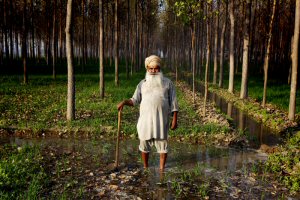 |
| Click to enlarge. © J. Carl Ganter. |
Photo 1 (right): Desraj Khai, 57, has worked the Sekhon family’s land for nearly five decades, since the start of the Green Revolution, when Western crop scientists introduced Punjabi farmers to hybrid seeds, chemical fertilizers, and chlorine-based weed and insect killers. But free water and energy to farmers like Khai are causing food waste and power shortages in India. Farm policies intended to remove risk from the grain-producing economy have pulled the country from the perennial fear of famine. But inefficient bureaucracy and rampant corruption also promote the squandering of resources — like using water for flood irrigation — and a glut of food that is not reaching the poor.
Photo 2: One among millions: A lone man watches a hawk fly over Delhi’s crowded skyline, which is topped with thousands of private water tanks that supply the city of 22 million. Corruption, bureaucracy, pollution, scarcity, slow environmental reviews, and inefficient transmission lines are causing ongoing water crises and unstable energy supplies across the country. (Published as part of Choke Point: the competition between water, food and energy in a changing climate.)
Photo 3: Deep wells form the center pivot for the swaths of circular irrigation systems that draw from the Ogallala Aquifer. Six decades have passed since grain growers and cattle producers began tapping the aquifer with such sustained thirst that they drew more water to the surface each year than flows in the Colorado River. Now the eight-state, $30 billion agriculture and livestock industry that has relied on the aquifer for its own wealth and to produce one-fifth of the nation’s corn, wheat, and cattle faces a new era of reckoning. Scuttling decades of habit, legal precedence, and cultural resistance, agriculture on the Great Plains reluctantly moves toward decisions on water use, crop yields, and profits that have been put off for decades.
Photo 4: John Burchard, general manager of the Alpaugh Community Services District, walks a ditch bank on the outskirts of town. The small farmworker community in California’s Central Valley suffers from high levels of arsenic and other contaminants in its drinking water. Severe groundwater pollution is further stressing California’s seriously limited water supplies.
Photo 5: Kettleman City, Calif., resident Maria Salcedo’s ten-month-old daughter, Ashley Alvarez, died from complications stemming from multiple birth defects during a rash of such occurrences between 2007 and 2008 in this small farmworker town in the Central Valley. Contaminated drinking water is viewed as one of the potential causes.
Judges' comments: From India to the Midwest to California, J. Carl Ganter, Matt Black and Brian Lehmann capture in both intimate portraiture and dramatic aerials the changes to lives and landscape brought and wrought by the world's quest for water.
Third Place
"Ice Bears on the Edge" by Jenny E. Ross, for Natural History
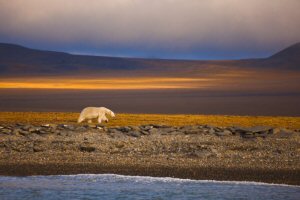 |
| Click to enlarge. © Jenny E. Ross. |
Photo 1 (right): Illuminated by dramatic light at sunset as a storm approaches, a young adult male polar bear (Ursus maritimus) wanders along the ice-free shoreline of Wrangel Island in the Russian High Arctic at the edge of the East Siberian Sea (Arctic Ocean), searching for something to eat. The bear was marooned on land food-deprived, and obliged to subsist on his body fat reserves, because the sea ice necessary for hunting had melted throughout the region and receded far to the north as the result of climate change. Polar bears are obligate carnivores and a blubber-rich diet of marine mammals is essential for their survival, but they can't catch their quick-swimming prey without utilizing a sea-ice platform in some manner. When polar bears are stranded ashore and unable to hunt seals, their primary prey, they occasionally snack on birds' eggs, kelp and other plants, and even human garbage in some locations. Such alternative foods may temporarily fill an empty belly, but they don't provide sufficient nourishment to sustain a polar bear for an extended period of time. In the past, the ice remained near Wrangel Island even in summer, enabling polar bears to hunt seals in the biologically-productive continental shelf region year-round. Now, however, because of rising temperatures, the sea ice recedes toward the very deep waters of the central polar basin in summer and may not return to coastal areas until late autumn or even early winter. Therefore, hungry bears may be stranded on Wrangel Island for several months without the ability to hunt for seals. The polar bear is listed as a Threatened species under the U.S. Endangered Species Act, and is designated as a Vulnerable species on the IUCN Red List. The species is imperiled primarily due to loss of its sea-ice habitat. If current temperature and sea-ice trends continue, scientists anticipate that two-thirds of the world's polar bears will disappear by 2050, and the species could be extinct in the wild by the end of the century.
Photo 2: An adult male polar bear begins to eat the body of a young bear (a yearling cub, about 19 months old) he killed for food on rapidly-melting summer sea ice in northern Olgastretet in the Barents Sea (Arctic Ocean), within the Svalbard archipelago. I first observed the adult male bear on an ice floe from a considerable distance away. I could see that he had just made a kill, and then I realized his prey was a yearling cub. The blood on the dead bear was very fresh and still flowing, the body was limp, and the young animal appeared to have just died. The cub had been severely bitten in the head, in the same manner of attack that a polar bear would use to kill a seal. As my boat began to approach, the adult male bear initially continued feeding on the cub and looked up at the boat occasionally. When I got closer, he straddled the young bear's body and stood stiffly over it, adopting a possessive posture that strongly communicated his control of the kill. He stared directly and continuously at my boat, as if to assert the warning "this is MY food." Then he grabbed the back of the cub's body in his teeth, and moved away quickly — transporting the carcass with him using only the power of his jaws and neck while running across the ice, climbing over pressure ridges, and swimming from floe to floe in an impressive display of strength. Ultimately, when he was again a considerable distance away, he resumed feeding on the cub's body. Based on my observations and all the surrounding circumstances involved, it was clear the adult male had killed the young bear specifically in order to eat it. Such incidents are believed to be rare; however, as the Arctic sea ice polar bears require for hunting seals continues to disappear due to rising Arctic temperatures, scientists think such tragic instances of intraspecific predation may become more common.
Photo 3: A sub-adult male polar bear climbs precariously on the face of a cliff above the ocean at Ostrova Oranskie in the Russian high-arctic archipelago of Novaya Zemlya, attempting unsuccessfully to feed on eggs in the nests of Brünnich's guillemots (Uria lomvia). Glaucous gulls (Larus hyperboreus) lurk nearby, also hoping to eat eggs. This bear was marooned on land, unable to hunt seals because the sea ice had melted throughout the region and receded far to the north as the result of climate change. By climbing on the face of a cliff to seek birds' eggs, this hungry polar bear endangered his life and probably expended more calories than he would have gained even if he had been able to eat some eggs.
Photo 4: A large adult female polar bear pauses while meandering along the rocky coast of Phippsoya (Phipps Island) in the Svalbard archipelago, and nibbles on a patch of dried seaweed that washed ashore. Marooned on this desolate Arctic island, the bear was unable to hunt seals because the sea ice had melted throughout the region and receded far to the north as the result of climate change. Phippsoya is one of the northernmost islands in Svalbard, at nearly 81-degrees North. In the past the sea ice remained near this island even in summer, enabling polar bears to hunt seals in the biologically-productive continental shelf region year-round. Now, however, because of rising temperatures, the ice often recedes toward the very deep waters of the central polar basin in summer and may not return to coastal areas until late autumn or even early winter. Therefore, hungry bears may be trapped on land there for several months without the ability to hunt for seals. Consequently, in a number of locations polar bear populations are declining, and some bears are starving to death during ice-free periods while waiting in vain for the sea to freeze.
Photo 5: An extremely thin adult male polar bear lies on the ground near the edge of western Hudson Bay, Canada in late November, waiting for sea ice to form and trying to conserve his energy. The bear had been marooned on land since early July when the ice broke up on Hudson Bay, and he had been food-deprived during that time because polar bears cannot hunt seals in the absence of sea ice.
Judges' comments: Many people talk about the plight of the polar bear with the melting ice of climate change. Jenny Ross makes the impact real with her heartbreaking images, including the cannibalism of a cub.
Rachel Carson Environment Book Award
First Place
"Toms River: A Story of Science and Salvation" by Dan Fagin
 Published by Bantam Dell/Random House
Published by Bantam Dell/Random House
Judges' comments: Many of the 36 books judged in this year's Rachel Carson Book Award category were strong contenders for one reason or another. But none came close to Dan Fagin's masterpiece, "Toms River: A Story of Science and Salvation,"& for how it embodies Carson's legacy of deeply insightful, science-based literary prose that helps readers better understand connections between public health and the environment. This book stood out for its superb combination of compelling narrative and for its explanations of science and history. "Toms River" not only navigates readers through the highly complex worlds of epidemiology and toxicology, but does so with style, conviction, and a voice of authority. Through his exhaustive research and the way in which he connected dots that needed to be connected, Fagin put readers on a journey that shows how corporate greed and industrial pollution overwhelmed a small New Jersey town with chemical dumping, resulting in a childhood cancer cluster. This thought-provoking work speaks to how the tragic tale of Toms River can happen — and is happening — other places.
Honorable Mention
"The Future Is Not What It Used to Be: Climate Change and Energy Scarcity" by Jorg Friedrichs
Judges' comments: This is a rare find among the many books written about climate change over the years, one that explores how humans are not only depleting natural resources but also — because of how the world has changed — are naive to assume the kind of transitions that have occurred between climatic eras can ever happen again. Through an astute and well-reasoned argument, Friedrichs — citing past cases in which climate stress was exacerbated by energy scarcity — takes a systematic look at how infinite growth is not possible and how — rather than just shifting from one energy market to another — the support structure for the industrialized world itself could be in danger of collapse. Whether or not you want to believe civilization itself is on a collision course with a destiny it cannot yet see or predict, this Oxford University scholar's work is chilling, mind-bending and creatively forward-thinking, without being sentimental. It offers a perspective that goes well beyond floods, hurricanes, and a warmer planet.
Honorable Mention
"The Devil & the Deep Blue Sea: An Investigation into the Scapegoating of Canada’s Grey Seal" by Linda Pannozzo
Judges' comments: Far more than a monograph about the plight of a single wildlife species, "The Devil & the Deep Blue Sea: An Investigation into the Scapegoating of Canada's Grey Seal" packs a lot of punch into 192 pages. Pannozzo takes readers deep inside the world of seal hunting while making a case for how government officials have seemingly used the seal as a scapegoat for the collapse of the Atlantic cod fishery when they should have, instead, been looking at the government's own mismanagement of cod stocks. By blaming seals and proposing large-scale culls, officials have deflected attention away from the more difficult and complex issues of climate change and destructive fishing methods, she argues. The author goes well beyond the obvious with independent research, vivid scene-setting and eloquent writing while questioning the motives of government officials. This tale of a species attempting to make a comeback in the face of adversity is an outstanding examination of the environmental consequences of bureaucratic finger-pointing.
Esteemed Judges, 2014 SEJ Awards for Reporting on the Environment
Erin Ailworth, Staff Writer, The Boston Globe
Erik Anderson, Reporter, KPBS Radio
Jim Bettinger, Director of Knight Fellowships, Stanford University
Seth Borenstein, Science Writer, The Associated Press
Frank Carini, Editor, ecoRI News
Audrey Cooper, Assistant Metro Editor, San Francisco Chronicle
Jackleen de La Harpe, Freelance Journalist
John Dillon, News Director, Vermont Public Radio
Peter Dykstra, Publisher, Environmental Health News
Sarah Elton, Author, "Consumed: Food for a Finite Planet"
Elizabeth Grossman, Independent Journalist
David Harrison, Reporter, Stateline.org
Thomas Henry, Staff Writer, The (Toledo) Blade
Derrick Jackson, Columnist/Associate Editor, The Boston Globe
Bill Luster, Photographer, Louisville Courier-Journal (retired)
Anne Paine, Reporter, The Tennessean (retired)
Ray Ring, Senior Editor, High Country News
Neena Satija, Environment Reporter, Texas Tribune
Susan Sharon, Deputy News Director, Maine Public Broadcasting Network
Douglas Struck, Freelance Journalist
JoAnn Valenti, Emerita Professor of Communications
2014 Awards Committee
Co-Chairs:
Beth Daley, New England Center for Investigative Reporting and formerly of The Boston Globe
James Bruggers, The (Louisville) Courier-Journal
Committee Members:
Emilia Askari, Independent Journalist
Jeff Burnside, Senior Investigative Reporter, KOMO TV Seattle
Director of SEJ Awards
Chris Bruggers, Rigel Consulting














 Advertisement
Advertisement 




